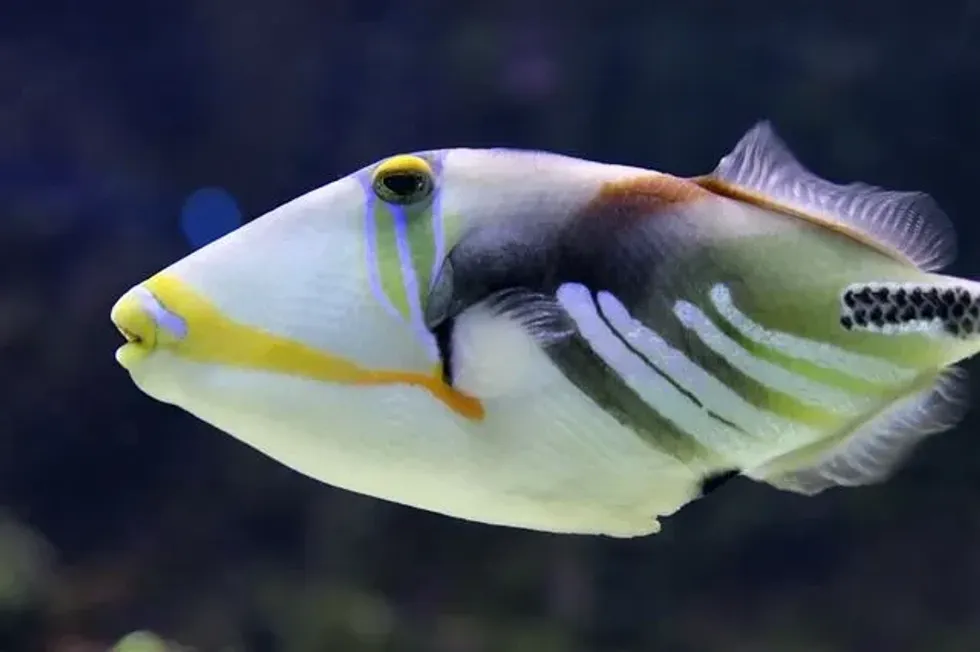Triggerfish of the Balistidae family get their name from their dorsal locking spine, which acts as a locking device for these fish. The most common triggerfish species is known as the gray triggerfish, but several triggerfish also contain orange, red, blue, yellow, and green colors, and patterns like lines and spots.
They are colorful aquarium fish with a large head and a small mouth. They have powerful jaws, and triggerfish teeth are well-chiseled too.
They dwell in subtropical and tropical parts of the world and the highest number of triggerfish inhabit the Indo-Pacific ocean. They are also found widely in the Black Sea, the Mediterranean Sea, and northern parts of the Atlantic Ocean.
Triggerfish hide well from their predators (such as reef sharks) using their caudal fin. There are lots of different well-known species of triggerfish, including lagoon triggerfish, pink tail triggerfish, Picasso triggerfish, reef triggerfish, and Hawaiian black triggerfish.
Titan and Picasso triggerfish aggressively guard their eggs. So, due to their large size and strong jaws, Titan triggerfish pose a significant threat to divers.
If you find this information helpful, you may also want to read about swai fish and lungfish here on Kidadl!
Triggerfish Interesting Facts
What type of animal is a triggerfish?
Triggerfish are marine saltwater fish. They are popular aquarium fish.
What class of animal does a triggerfish belong to?
Triggerfish belongs to the fish class of animals.
How many triggerfish are there in the world?
Whilst the exact number of triggerfish is unknown, we do know that there are more than 40 species of triggerfish in the world.
Where does a triggerfish live?
Triggerfish live in the ocean.
What is a triggerfish's habitat?
A typical triggerfish habitat is found in shallow coastal marine waters. In search of food, some species live around coral reefs and at the bottom of the ocean.
In places with no reefs, triggerfish live in rocky outcrops. Some are found in pelagic regions (open waters) too. Demersal zone triggerfish live closer to the bottom of the ocean than reef species do.
Who do triggerfish live with?
Triggerfish live on their own as they are highly territorial of their spawning area.
How long does a triggerfish live?
Triggerfish can live for up to eight years. The maximum lifespan of a triggerfish is 13 years.
How do they reproduce?
Triggerfish reach sexual maturity at around two years of age. Males are responsible for preparing the ground for spawning and for building seafloor nests and tents in their territory. Some species, like the gray triggerfish and the yellow margin triggerfish, create pretty hollow nests.
Male triggerfish guard both the eggs and females and females tend to the eggs by providing oxygen by blowing water over them until the eggs hatch. The eggs of yellow margin triggerfish and crosshatch triggerfish spawn in the morning and hatch in the evening.
Once the eggs have hatched the young fish move up to the surface. A young triggerfish's diet includes barnacles, hydroids, and polychaetes.
What is their conservation status?
Some triggerfish species are popular aquarium fishes. So, the aquarium trade and overfishing are a threat to these fish. Human factors causing habitat loss, pollution, climate change, and predators like large fish and sharks are also a threat to triggerfish.
Triggerfish Fun Facts
What do triggerfish look like?
Many species of triggerfish are oval-shaped, thin, stout, and hard-skinned fishes with a large spine. They have three sets of spines with anterior dorsal fins. A few triggerfish species are diamond-shaped. Triggerfish have a large head that takes up to one-third of their body, with large eyes and a small mouth.
Triggerfish also have two pelvic fins and a sickle-shaped caudal fin. Their anal and dorsal fins are large. They are often brightly colored and contain markings like spots and stripes. All species have a lyre-shaped tail.
How cute are they?
They are not conventionally cute but the clown triggerfish (Balistoides conspicillum) is recognized as beautifully colored worldwide. Reef and Picasso triggerfish tend to have prettier colors than Titan and gray triggerfish.
How do they communicate?
Triggerfish use their strong jaws and grind their teeth to create sounds when they spot an invader near their territories. They also communicate using touch and by digging the ground to create a nest.
How big is a triggerfish?
Triggerfish are small or medium in size, but in case of a threat, triggerfish can create an illusion to look as thin as seaweed. The stone triggerfish is a larger species than the gray triggerfish. They can sometimes grow to more than 30 in (100 cm) in length and can weigh 3-10 lb (1.4-4.5 kg).
How fast can triggerfish swim?
Triggerfish are slow swimmers and use their large anal and dorsal fins to propel themselves forward.
How much does a triggerfish weigh?
Triggerfishes weigh between 3-10 lb (1.4-4.5 kg).
What are their male and female names of the species?
There is no specific name given to males and females, but it is interesting to note that females are usually smaller in size than males.
What would you call a baby triggerfish?
Baby triggerfish are just known as young triggerfish.
What do they eat?
Triggerfish are bottom feeders. They usually flap away debris and squirt water onto the sand to get to the small animals that they eat as prey. Due to their robust set of teeth, they can easily feast on hard and small-bodied water invertebrates.
Triggerfish bite into the stomach of a sea urchin with their powerful mouth and feed on it easily as there are no spines. The triggerfish diet also includes clams, small fishes, armored prey, crabs, krill, squid, and starfish. Slow swimming creatures are their favorite prey.
Are they dangerous?
Triggerfish are dangerous when it comes to protecting their territory during the mating period. Larger species, like the Titan triggerfish, pose a threat to divers as their bite is stronger than that of other species.
Would they make a good pet?
Triggerfish are highly territorial fish. As this fish attacks other smaller fishes, it is safest to keep them alone in an aquarium. They are not a good pet at all, and only professionals should handle them. It is possible to keep more than one triggerfish together, but only if they are introduced at the same time.
Did you know...
Hawaii's state fish are the Picasso and reef triggerfish. These are popularly known as 'humuhumunukunukuapua'a' fish. Each consonant and vowel is pronounced in this name. 'Humuhumu' is a common name for a triggerfish, and 'nukunukuapua'a' means 'snort like a pig' as these fish grunt when they spot an intruder.
Due to the decline in the availability of some aquarium species of triggerfish, efforts are being made to understand their spawning process in more detail.
A crosshatch triggerfish can change from a female to a male in its lifetime.
Research on triggerfish shows that they are clever fish that can learn from their previous experience. Triggerfish cleverly make use of rocks to break through shellfish. When kept in aquariums, they also recognize their owners and are able to figure out human behavior.
By hunting down sea urchins from coral reefs, triggerfish contribute to the better health of these corals.
The queen triggerfish was the first to be bred in captivity in 2009.
Some triggerfish species secrete slime-like mucus from their skin for protection against infection and parasites. This also helps triggerfish to move swiftly through the water. This slime also contains certain toxins that keep predators at bay.
The ventral fin on the pelvic area provides stable movement for a triggerfish. This pectoral fin provides a stable side-to-side movement.
Do people eat triggerfish?
Not all species of triggerfish are edible. Gray triggerfish are a popular food but some species, like Titan triggerfish, are the cause of ciguatera fish poisoning in humans.
They should weigh under 5 lb (2.3 kg) if they are to be consumed and edible species have white meat. Triggerfish taste sweet when cooked, a little like crab meat. Any basic fish recipe works well with these fish as their fillets are thin and light.
They can be cooked in an oven for approximately five minutes at 325 F (160 C). You will know that they are cooked when the white flesh flakes up if scraped with a fork.
Different kinds of triggerfish
With more than 40 species of triggerfish, each of these is found in different parts of the ocean. Clown triggerfish (Balistoides conspicillum) have a black body with white spots and are usually found around demersal zones.
Picasso triggerfish (Rhinecanthus aculeatus) are tan with black, blue, and yellow stripes. They are also called black bar triggerfish, Jamal, and Picassofish. This popular Hawaii state fish is often found in shallow and sandy parts of the reef.
Gray triggerfish (Sufflamen bursa) are normally olive-gray and can change their color to dark charcoal gray during the spawning season. Gray triggerfish are often found near rocky areas.
As the name suggests, pink tail triggerfish (Melichthys vidua) have a translucent whitish-pink tail and dorsal fins. They have a blackish-green body and they are found around a coral reef.
Queen triggerfishes are light-colored. They are mainly of turquoise, green, or purple colors, with light blue stripes. They occupy rocky and coral reef habitats and they primarily feed on sea urchins.
The blue triggerfish (Odonus niger) are bluish-green and dark purple with light blue markings. They have tiny red teeth and are a calmer trigger compared to other species. They are often found near reef channels where water currents are high.
Undulated triggerfish (Balistapus undulatus) are also called orange-lined triggerfish and are green with light orange stripes spaced equally on their bodies. They are often found in seaward reefs and deep lagoon areas. They are more aggressive than other species.
Finally, crosshatch triggerfish (Xanthichthys mento) are given this name as they have a yellow crosshatch pattern on their body. They also have a pink tail and green fins.
Here at Kidadl, we have carefully created lots of interesting family-friendly animal facts for everyone to discover! Learn more about some other fish including the king salmon, or the Pacific salmon.
You can even occupy yourself at home by drawing one on our salmon coloring pages.










